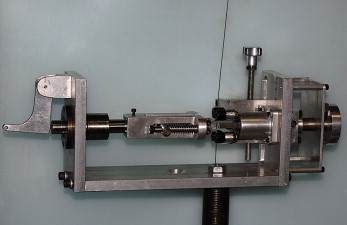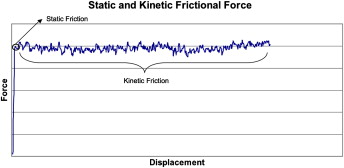Introduction
The aim of this study was to evaluate the frictional resistance between active and passive self-ligating brackets and 0.019 × 0.025-in stainless steel archwire during sliding mechanics by using an orthodontic sliding simulation device.
Methods
Maxillary right first premolar active self-ligating brackets In-Ovation R, In-Ovation C (both, GAC International, Bohemia, NY), and SPEED (Strite Industries, Cambridge, Ontario, Canada), and passive self-ligating brackets SmartClip (3M Unitek, Monrovia, Calif), Synergy R (Rocky Mountain Orthodontics, Denver, Colo), and Damon 3mx (Ormco, Orange, Calif) with 0.022-in slots were used. Frictional force was measured by using an orthodontic sliding simulation device attached to a universal testing machine. Each bracket-archwire combination was tested 30 times at 0° angulation relative to the sliding direction. Statistical comparisons were performed with 1-way analysis of variance (ANOVA) followed by Dunn multiple comparisons. The level of statistical significance was set at P <0.05.
Results
The Damon 3mx brackets had significantly the lowest mean static frictional force (8.6 g). The highest mean static frictional force was shown by the SPEED brackets (83.1 g). The other brackets were ranked as follows, from highest to lowest, In-Ovation R, In-Ovation C, SmartClip, and Synergy R. The mean static frictional forces were all statistically different. The ranking of the kinetic frictional forces of bracket-archwire combinations was the same as that for static frictional forces. All bracket-archwire combinations showed significantly different kinetic frictional forces except SmartClip and In-Ovation C, which were not significantly different from each other.
Conclusions
Passive self-ligating brackets have lower static and kinetic frictional resistance than do active self-ligating brackets with 0.019 × 0.025-in stainless steel wire.
There has been increased use of self-ligating brackets in recent years, and several claims have been made regarding their performance compared with conventional edgewise brackets. Recent manufacturing modifications of brackets aimed at reducing friction between the archwire and the bracket slot are based on improved surface quality, slot geometry modifications, varied bracket width, and integrated ligation systems. It has been reported that friction is determined largely by the nature of the ligation. Therefore, various ligation systems have been introduced with the edgewise bracket to secure the wire in the bracket. Some self-ligating brackets have a spring clip that presses against the archwire, such as In-Ovation R and In-Ovation C (GAC International, Bohemia, NY) and SPEED (Strite Industries, Cambridge, Ontario, Canada). These brackets have been described as active self-ligating because there might be a ligation force during sliding mechanics. Other self-ligating brackets such as Damon 3mx (Ormco, Orange, Calif), SmartClip (3M Unitek, Monrovia, Calif), and Synergy R (Rocky Mountain Orthodontics, Denver, Colo) have a clip-gate that does not press against the wire during sliding mechanics. These are described as passive self-ligating brackets.
Self-ligating brackets have been reported to have lower frictional forces during sliding mechanics and require less chair-side assistance. They are generally smoother, more comfortable for the patient, and easier to clean. According to Thorstenson and Kusy, the lower friction of self-ligating brackets might be partly explained by a greater critical contact angle with the wire. There are conflicting claims of superior performance regarding friction for both passive and active self-ligating brackets. This conflict might be due to the wide variations in data reported in previous studies. Some studies show wide ranges between minimum and maximum values, and others have reported mean frictional force values with high standard deviations, making it difficult to determine whether there are significant differences between brackets.
In orthodontics, research efforts to understand the factors that influence frictional resistance when considering sliding mechanics have been focused on bracket width, archwire material, archwire size, second-order angulation, ligation type and technique, effect of saliva, and interbracket distance. These factors are critical when considering the clinical application of sliding mechanics.
According to Pizzoni et al, experimental setups to determine the effect of the above-mentioned factors on friction can be divided into 4 main groups: (1) archwires sliding through contact flats; (2) archwires sliding through brackets parallel to the brackets slot; (3) archwires sliding through brackets with different second- and third-order angulations; and (4) brackets submitted to a force with a certain degree of tipping allowed. The experimental design of this study provided for archwires sliding through brackets parallel to the bracket slot; it falls into the second group.
Our hypothesis was that there is no significant difference in the resistance to sliding of a 0.019 × 0.025-in stainless steel archwire between active and passive self-ligating brackets. The purpose of this study was to compare the static and kinetic frictional forces generated between active and passive self-ligating brackets by using a sliding simulator coupled with a 10-N load cell.
Material and methods
An orthodontic sliding simulation device modified from that reported by Articolo and Kusy and Articolo was used to simulate the clinical use of orthodontic brackets ( Fig 1 ). The simulation device consisted of a special fixture mounted to the base of a mechanical testing machine (model 4206, Instron, Canton, Mass). The fixture held a bracket slot that allowed for reproducible bracket positioning and was attached to an angulation dial. A test archwire was suspended from a collet connected to the force transducer and the transverse beam of the testing machine. The orthodontic device was modified for self-ligating brackets by removing 0.010 in of ligature wire attached to a piston assembly to transmit a normal force. The weight of the collet holding the archwire was reduced to minimize noise in data collection.

The brackets were cemented onto the simulation device bracket slot and initially set to be passive (0°) in the second order via the adjustable angulation dial. All tested brackets had –7° of torque and 0° of second-order angulations, with the exception of Damon 3mx, which has 2° of distal offset. The 2° distal offset of the Damon 3mx bracket was compensated for by using the angulation dial. All angulations and torque values of the brackets remained fixed during data collection. During testing, the transverse beam with the collet holding a 0.019 × 0.025-in stainless steel archwire was lifted up to draw the archwire through the bracket. The drawing force was monitored by the machine’s load cell (10 N) and transmitted to computer software (version 2.0, Measure, National Instruments, Austin, Tex) for plotting drawing force vs distance charts.
Maxillary right first premolar brackets with 0.022-in slots and prescriptions as described above were used. Each archwire-bracket couple was cleaned with 95% ethanol and compressed air just before evaluation. All testing was done in the dry state in prevailing air at 21°C. Each test consisted of 1 bracket and 1 archwire at 0° angulation. Two examiners (N.T. and S.S.) verified proper mounting of the brackets under 10-times magnification. The static frictional force was measured as the initial rise or peak force required to initiate movement of the wire through the bracket ( Fig 2 ). The peak force was halved and defined as static frictional force. A new bracket-archwire combination was used for each test. Each test was performed 30 times.

The drawing force required to maintain movement beyond the point of initial displacement was averaged and then halved and recorded as the kinetic frictional force. The archwire was drawn through the bracket a distance of 20 mm at a speed of 1 cm per minute for determination of kinetic friction. Data were obtained at a rate of 5 scans per second for 2 minutes.
The 1-way analysis of variance (ANOVA) and the Dunn multiple comparison tests were performed with statistical software (version 3.5, SigmaStat, Systat Software, Point Richmond, Calif). The level of statistical significance was set at P <0.05.
Results
A plot of force vs displacement obtained during friction testing is shown in Figure 2 . The region for determining static friction was designated “static friction,” and regions for determination of kinetic friction were called “kinetic friction.” Table I shows the results of the mean static frictional forces for the brackets investigated. Statistical analysis showed that passive self-ligating brackets ranked as follows from lowest to highest mean static friction: Damon3mx (8.6 g), Synergy R (23.8 g), and SmartClip (30.3 g). The static friction of the passive self-ligating brackets was significantly different from each other. Among the active self-ligating brackets, the ranking from lowest to highest static friction was In-Ovation C (33.4 g), In-Ovation R (38.1 g), and SPEED (83.1g). The active self-ligating brackets showed significantly higher static frictional forces than the passive self-ligating brackets.
| Bracket | Mean (g) | SD | Median (g) | Minimum (g) | Maximum (g) |
|---|---|---|---|---|---|
| Damon 3mx | 8.6 | 0.4 | 8.6 | 7.9 | 9.3 |
| In-Ovation R | 38.1 | 1.6 | 38.2 | 34.2 | 41.6 |
| In-Ovation C | 33.4 | 1.2 | 33.3 | 30.3 | 35.3 |
| SmartClip | 30.3 | 2.3 | 30.3 | 26.8 | 36.0 |
| SPEED | 83.1 | 2.5 | 82.6 | 79.3 | 89.3 |
| Synergy R | 23.8 | 1.5 | 23.8 | 21.4 | 27.8 |
Stay updated, free dental videos. Join our Telegram channel

VIDEdental - Online dental courses


